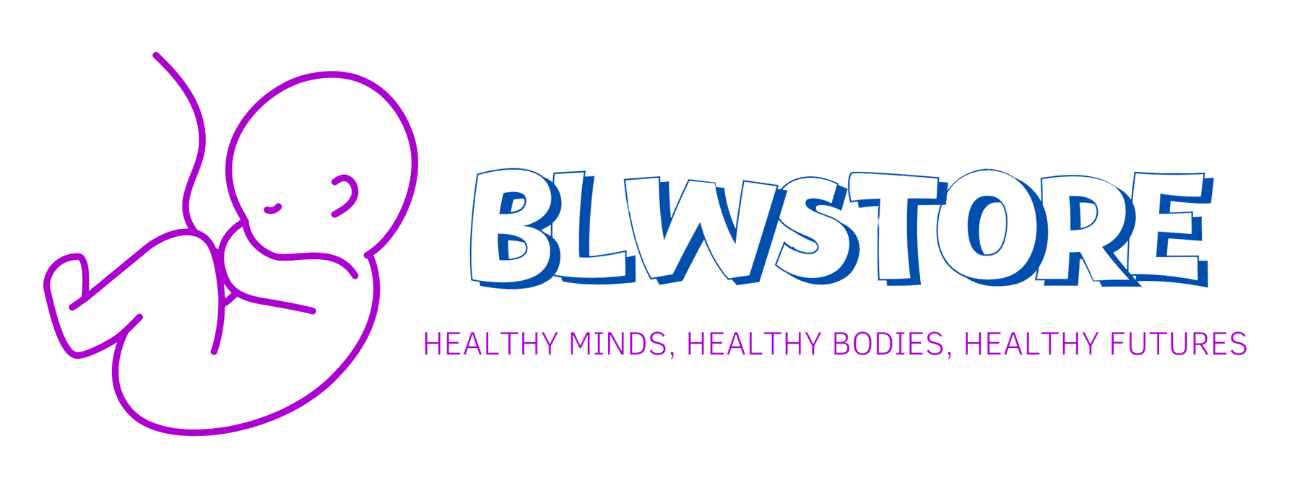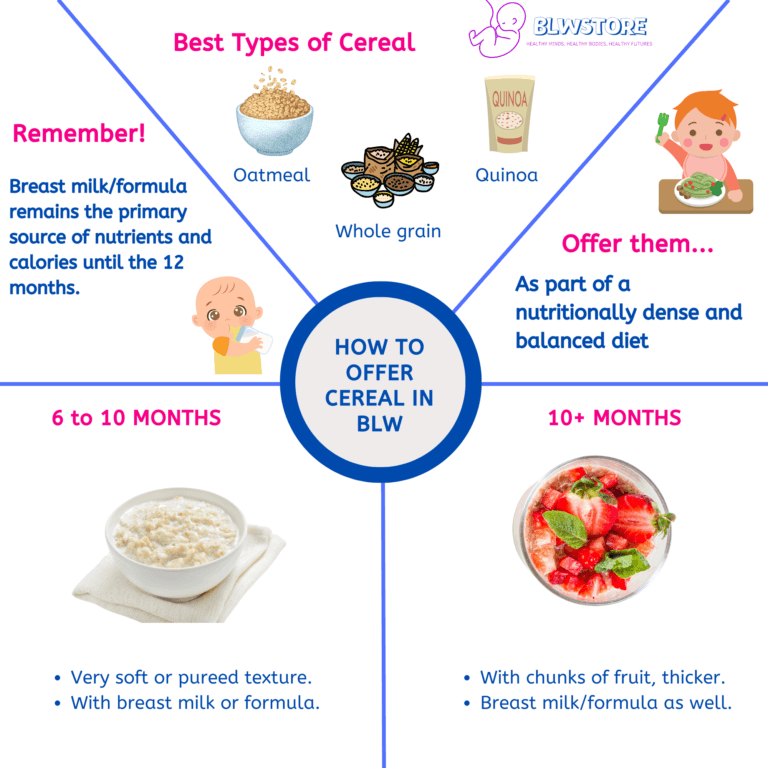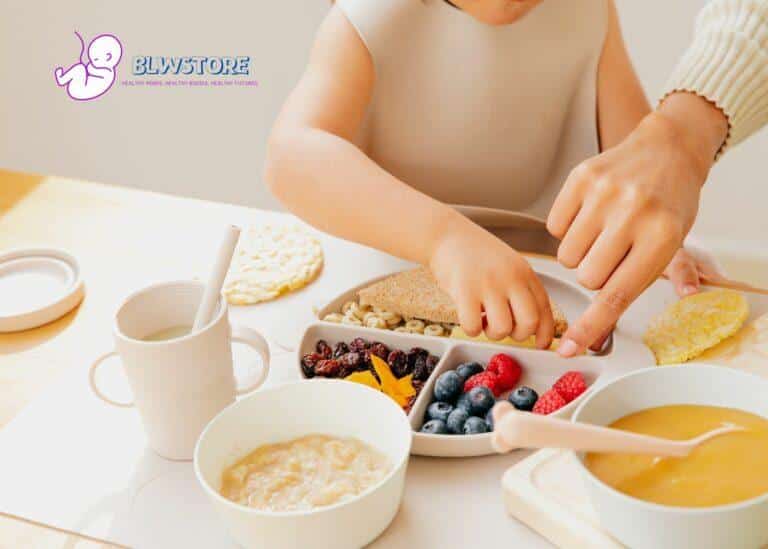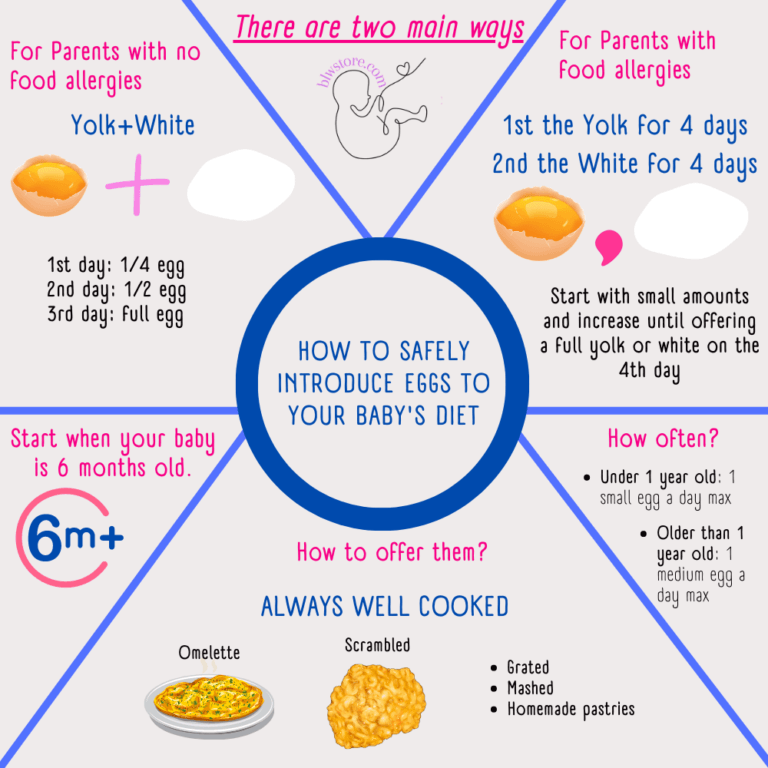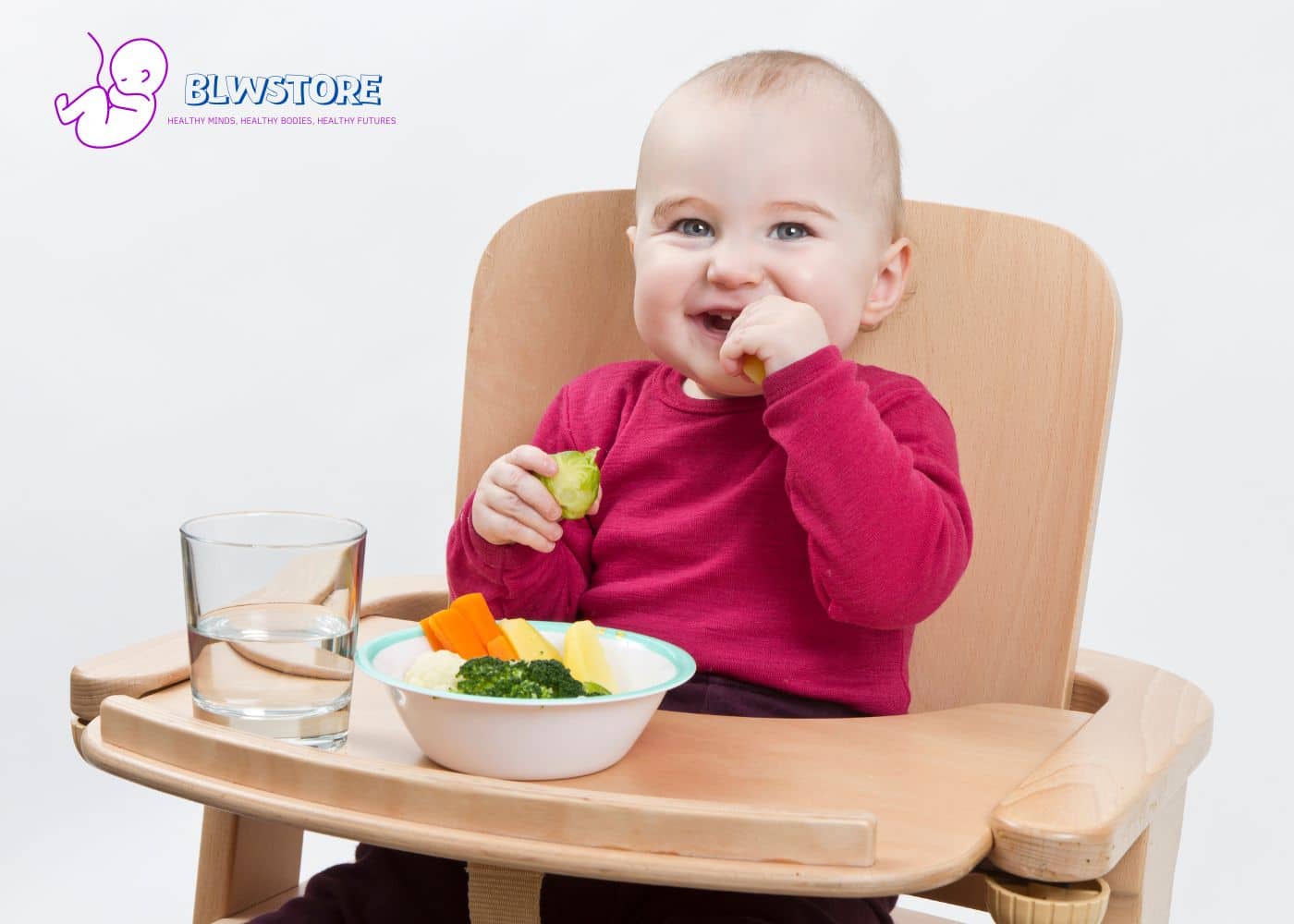
Welcome to “How to Introduce Solid Foods to Your Baby: The Ultimate Guide” – the only resource you’ll ever need to transform this milestone into a delightful experience for you and your little one.
We crafted this article with one purpose: that you, after reading, know everything you need to start solids with your little one with trust and confidence.
We will cover all the fundamental aspects of introducing solids. If you have any questions left after reading, you can contact us at [email protected] and we’ll be happy to help with anything you need.
Let’s get started!
The Short Answer
| Key Takeaways | Details |
|---|---|
| Signs of readiness for solid foods | Good head and neck control, interest in food, not pushing food out of mouth, and weighing twice birth weight |
| Ideal age to start solids | 6 months, but consider individual needs |
| Gradual introduction of diverse foods | Introduce even if initial dislikes occur, insist |
| Important nutrients for babies | Protein, Calcium, Whole Grains, Fruits, Vegetables, High-fat foods, Iron-rich foods, Omega-3 sources, and Fluids |
| Cereals are not necessary and can be detrimental | Avoid for baby’s health |
| Breast milk or formula on demand | Amount babies eat varies |
| Great first foods | Avocado, banana, cooked veggies, eggs; caution with tomatoes, hummus, mashed chickpeas, yogurt |
| Introduce allergenic foods early | Reduces food allergy risks; common allergens include cow’s milk, eggs, peanuts, tree nuts, wheat, soy, fish, shellfish, and sesame |
| Encourage variety in baby’s diet | Spice up meals, avoid sweets as rewards, choose whole grains, swap unhealthy options |
| Avoid force feeding | Encourage exploration, self-feeding, use appropriately sized utensils for picky eaters |
| Establish healthy eating habits | Limit screen time, ensure proper seating, model healthy choices, share family meals, view food as nourishment |
| Gagging vs. choking | Gagging is normal, not dangerous; choking requires immediate attention and proper techniques |
| Constipation and diarrhea management | Natural remedies for constipation; maintain hydration for diarrhea, seek medical advice if needed |
| Reflux and spit-up management | Resolve on their own; manage by burping, feeding upright, offering smaller, frequent meals |
| Managing toddler tantrums | Empower within boundaries, stay calm, ignore tantrums, use distractions |
Related reads: Best Protein Sources for Babies | Best Carb Sources for Babies | Best Fat Sources for Babies
When Can Babies Have Solids?
Signs of readiness for solid foods include good head and neck control, interest in food, not pushing food out of the mouth, and weighing twice the birth weight.
The ideal age to start solids is 6 months, but individual needs should be considered.
Introduce diverse foods gradually, even if initial dislikes occur.
Signs of Readiness
As a new parent, you might be wondering: When is the right time to introduce solid foods to my baby? The answer lies in looking for specific signs of readiness, such as:
- Good head and neck control
- Interest in food
- No pushing food out of their mouths
- Weighing twice their birth weight or close to it
Recommended age

According to doctors, the ideal time to start solid foods is when your baby reaches 6 months old.
This is because, by this age, your baby’s digestive system is developed enough to handle a more diverse range of foods, and it is when they will benefit from having more iron content in their diet.
Adjusting to Individual Needs
Remember that every baby is unique, and their readiness for solids may vary. It’s essential to cater to your baby’s needs and not rush the process.
6 months is, on average, the perfect time to start with solids. However, your baby could be different, do not feel forced to do it if your baby has not shown signs of readiness yet.
Introducing various foods from all food groups is essential for your baby’s growth and development. Don’t give up if your baby doesn’t initially like something. It may take multiple tries before they develop a taste for it.
What Are the Nutritional Needs of Babies?
Babies receive essential nutrients from breast milk or formula.
As they grow, introduce solid foods with lean meats, calcium sources, whole grains, fruits, vegetables, high-fat foods, iron-rich foods, and omega-3 sources.
Avoid cereals. Offer breast milk/formula on demand.
What are the Essential Nutrients for Babies?
It may be a relief to know that babies receive all the nutrients they need from breast milk and/or formula in the first six months.
During this time, their nutritional needs are met without introducing any solid foods.
As your baby grows, however, solid foods become increasingly important.
| Food Type | Examples | Nutrients |
|---|---|---|
| Protein | Meats, organs, poultry, fish, eggs | 20-30g/day for meat/poultry, 30-40g/day for fish, 1 small egg/day |
| Calcium | Breastmilk or infant formula | No additional sources needed; breastmilk/formula on demand |
| Whole Grains | Oats, whole wheat bread, quinoa | Offer 1-2 servings per day |
| Fruits | Banana, apples, mangoes, papaya | Rich in vitamins A, C, and E |
| Vegetables | Broccoli, green beans, peas | Rich in vitamins A, B, C, and E |
| High-fat foods | Avocado, nut butters | Offer in moderation |
| Iron-rich foods | Beans, lentils, broccoli | Offer 1-2 servings per day |
| Omega-3 sources | Chia seeds, flaxseeds, walnuts, fatty fish | Offer 1-2 servings per day |
| Fluids | Breastmilk, infant formula, water (optional) | Breastmilk/formula on demand; offer water if needed |
Why are no cereals on the list?
We are aware that plenty of people and “experts” in the field recommend offering iron-fortified cereals as one of the first foods, but they are not necessary, in fact, they could be detrimental to your baby’s health.
Cereals are simple sugars that offer virtually no nutritional value compared to real, unprocessed foods such as fruits, vegetables or nuts.
They are simple carbohydrates that are easy to digest and provide quick energy, but they also cause spikes in blood sugar that can affect your baby’s health, tastes, and cravings in the future.
We assure you that offering only healthy, “real, unprocessed” foods is the best way to create a healthy relationship with food for your baby.
How Much Should a Baby Eat?
You may be wondering how much your baby should be eating.
The answer varies, but as long as your baby is growing at a healthy rate, they are likely getting enough nutrition.
Here’s a general guideline for babies aged 0-12 months:
- 0-6 months: always offer breastmilk or formula on demand. The 3-hour rule is old-fashioned and should not be followed. Your baby will tell you when they are hungry. You should change something if your baby does not grow properly at a normal ratio. Always talk to your pediatrician and make sure you don’t miss any check-ups.
- 7-12 months: Breast milk or formula remains the primary source of calories, and you should still offer them on demand. Additionally, it is recommended to start solids following the approach and guidelines you are most comfortable with (we will give you our recommendation later).
What is the best macronutrient distribution for infants?
| Age | Average Nutrient Needs | Tips |
|---|---|---|
| 0-6 months | Energy: 570-645 kcal/day, Protein: 9.1 g/day | Breast milk is the best source of nutrients during this period. |
| Fat: 31 g/day, Carbohydrates: 60 g/day | No complementary foods are needed. | |
| 6-12 months | Energy: 675-765 kcal/day, Protein: 11 g/day | Begin introducing solid foods, led by a pediatrician. |
| Fat: 30 g/day, Carbohydrates: 95 g/day | Ensure adequate iron, zinc, and vitamin D intake. | |
| 12-24 months | Energy: 860-950 kcal/day, Protein: 13 g/day | Offer a balanced diet with a variety of foods. |
| Fat: 30 g/day, Carbohydrates: 130 g/day | Encourage water intake and limit sugary drinks. |
This all sounds complicated, but don’t worry more than you have to.
Follow the advice we give you and if your baby is growing, all is well.
Always offer a balanced diet with fresh, unprocessed ingredients, and everything will be fine.
Best and Worst First Foods: What to Start With
Best first foods include avocado, banana, cooked veggies, and eggs (watch for allergies).
Be cautious with tomatoes, hummus, mashed chickpeas, and yogurt.
Avoid choking hazards like uncooked dried fruit and hard snacks.
Avoid fish with bones and high-sodium or sugary foods.
Best First Foods:
- Avocado and banana: These nutrient-dense fruits are excellent first foods for babies, provided in long strips they can hold and feed themselves. *Read: Banana for BLW | Avocado for BLW
- Cooked veggies: Sweet potato strips, yams, acorn squash, butternut squash, and other soft and mushable cooked veggies make great options for your little one. *Read: Broccoli BLW | Sweet potato BLW | Cauliflower BLW and many more!
- Eggs: Scrambled eggs or omelette strips are good protein sources. Remember to introduce eggs alone and watch for allergies. *Read: How to Introduce Eggs
Good Options, but Be Cautious:
- Tomatoes: Offer big wedges for babies to suck on, but avoid round fruits like grapes and cherry tomatoes. *Read: How to offer Cherries
- Hummus or mashed chickpeas: These can be served, but be cautious of potential allergens.
- Yogurt: Messy but safe and smooth for babies (9+ months)
Foods to Avoid:
- Choking hazards: Uncooked dried fruit, big gobs of nut butter, chunks of meat or cheese, popcorn, and hard snacks are all potential choking hazards. *Read: Foods to Avoid during BLW
- Fish with bones: Avoid these, and be cautious with high-sodium or highly sugary foods. *Read: How to offer salmon in BLW
How Do You Introduce Allergens To Your Baby?
Introducing allergenic foods early can reduce food allergy risks.
Common allergens include cow’s milk, eggs, peanuts, tree nuts, wheat, soy, fish, shellfish, and sesame.
Allergic reactions can range from mild to severe.
Steps to introduce allergens: choose, start small, one at a time, monitor, consult if unsure, and maintain exposure.
Did you know that introducing allergenic foods early in life can actually reduce the risk of developing food allergies?
In this section, we’ll explore common food allergens, signs and symptoms of allergic reactions, and provide a step-by-step guide on how to introduce allergenic foods to your little one.
What are the most common food allergens?
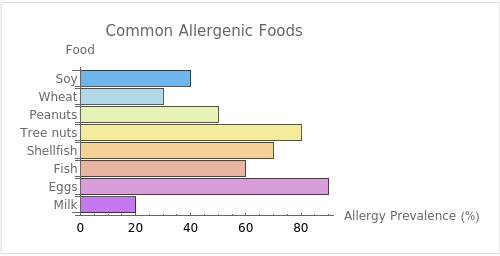
| Food | Approximate Allergy Prevalence |
|---|---|
| Cow’s milk | 2-3% in infants and children, 0.1-0.5% in adults |
| Hen’s egg | 0.5-2.5% in children, 0.1-0.2% in adults |
| Peanuts | 1-2% |
| Tree nuts | 0.5-1% |
| Wheat | 0.4% |
| Soy | 0.1-0.5% |
| Fish | 0.2-0.5% |
| Shellfish | 1-2% |
| Sesame | 0.1-0.2% |
What are the Signs and Symptoms of Allergic Reactions?
An allergic reaction can manifest in various ways, ranging from mild to severe.
Keep an eye out for these symptoms:
- Hives
- Swelling
- Vomiting
- Abdominal pain
- Coughing
- Wheezing
- Irritability
- Lethargy
Call emergency services immediately in case of severe symptoms and administer an adrenaline injection if available.
How to introduce allergens. Step by Step
These are the general steps, applicable for every allergen:
- Choose the allergen: Peanut butter and egg are often recommended as the first allergens to introduce.
- Start small: Begin with a small amount of the allergenic food.
- Introduce one food at a time: Wait three days before introducing another food.
- Monitor reactions: Keep a close eye on your baby for any signs of an allergic reaction.
- Consult a physician if unsure: If you notice any skin reactions, take photos and consult a healthcare professional.
- Maintain regular exposure: Continue to include allergenic foods in your baby’s diet.
Dealing with Food Allergies and Intolerances
If your baby has a cow’s milk allergy, breast milk, hypoallergenic formulas, goat milk formulas, or plant-based milk can be substitutes.
Remember that breast milk does not pass allergies and oral allergy syndrome to babies.
What are the Different Approaches to Introduce Solids?
Traditional weaning involves spoon-feeding purees, while baby-led weaning allows babies to explore finger foods independently.
Combining both methods offers flexibility, independence, and exposure to a variety of foods.
Your chosen method should prioritize a low-stress environment and following the baby’s cues.
Traditional Weaning | Purees
Traditional weaning, also known as spoon feeding or puree feeding, is the conventional approach to introducing solids to babies.
This method involves feeding the baby mashed or pureed foods with a spoon, controlled by the parent.
But is this method suitable for your little one? Let’s find out.
Pros and Cons of Traditional Weaning
| Pros ✅ | Cons ❌ |
|---|---|
| Tidier process | May make the baby dependent on the parent for meals |
| Less wastage | May hinder oral development |
| Easier to control portions | May not promote exploration of food textures |
| Suitable for a wide range of foods | Potentially more time-consuming preparation |
Baby-Led Weaning | BLW
Baby-led weaning (BLW) is an alternative approach that allows the baby to control their own eating by skipping purees and spoon-feeding altogether.
Instead, the baby is offered finger foods to explore and eat at their own pace. Are you curious to know how this method weighs up?
Let’s dive in.
*Read our personal take on: BLW vs Purees and the Benefits of Baby-Led Weaning
Pros and Cons of Baby-Led Weaning
| Pros ✅ | Cons ❌ |
|---|---|
| Promotes independence | Can be messy |
| Encourages exploration of food | Concern for gagging or choking (but is not riskier) |
| May prevent picky eating | Requires modification of family meals |
| Stimulates oral development | Might result in more food wastage |
Combination of Both | Purees + BLW
A combination of both traditional weaning and baby-led weaning involves offering the baby a mix of purees and finger foods. This method can provide flexibility and promote independence, oral development, and exposure to a variety of foods. Is this the best of both worlds? Let’s analyze the pros and cons.
Pros and Cons of Combining both
| Pros ✅ | Cons ❌ |
|---|---|
| Offers flexibility | Can be time-consuming to prepare |
| Encourages independence | May still involve some messiness |
| Supports oral development | Requires parental guidance for safe eating |
| Provides variety in food textures | Involves a learning curve for parents and babies |
Our Personal Experience With Introducing Solids To Our Son Pablo
Maria and I (Alberto) have always been interested in nutrition. For years, we have studied, learned, and applied what we consider to be correct.
Science has advanced, and fortunately, we now have a much better understanding, with knowledge being more easily shared.
When Maria became pregnant, we already had a solid knowledge base about nutrition. However, we quickly started learning about infant nutrition.
We took several courses, cross-referenced information from books and online sources (*Tip: never rely on a single source, gather information from multiple sources). Eventually, we acquired enough information to feel comfortable applying it.
Since our son Pablo turned 6 months old, we have been following the Baby Led Weaning method.
By implementing the strategies we share in our articles on this website, Pablo has become the best eater in his school.
Now, at almost 3 years old, he prefers healthy foods over those with excessive sugar. He eats a wide variety of fruits and vegetables, and occasionally indulges in less nutritious options (just like us).
We typically follow the 80/20 rule, where 80% or more of his diet consists of fresh and nutritious foods. The remaining 20% or less allows for more flexibility, although you’d be surprised how often Pablo prefers a banana or watermelon over a cookie or something less nutritious.
No matter your chosen method, the most important factor is to create a low-stress environment and follow your baby’s cues while introducing solid foods.
After all, the goal is to help your little one develop a healthy relationship with food that will last a lifetime.
So, which approach suits your family best?
How To Prepare and Store Baby Food
Homemade baby food offers higher nutritional value, cost-effectiveness, control over ingredients, and personalization.
Store-bought options may have lower nutritional value, contain preservatives, and offer convenience.
Safely prepare and store baby food, prioritize hygiene, and avoid flavoring agents.
Home-Made vs. Store-Bought Baby Food
| Homemade Baby Food | Store-Bought Baby Food |
|---|---|
| ✅ Higher nutritional value for proper development | ⛔ May have lower nutritional value compared to homemade food |
| ✅ More cost-effective than store-bought options | ⛔ Can be more expensive in the long run |
| ✅ Allows you to use organic ingredients to avoid chemicals | ⛔ May contain preservatives or additives |
| ✅ Gives you control over the ingredients and preparation methods | ⛔ Limited control over ingredients and preparation methods |
| ✅ Personalized to meet your baby’s specific needs | ⛔ Convenient option for time-pressed parents |
How do you prepare baby food safely
- Use a baby food steamer or a regular blender to steam and puree a variety of foods.
- Opt for fresh, organic fruits and vegetables for maximum nutrient content.
- Steam or bake foods to eliminate harmful bacteria and retain nutrients.
- ❌ Do not add flavoring agents like salt, sugar, or strong spices to baby food.
- Maintain cleanliness on work surfaces and ensure clean hands while preparing food.
How to store baby food
- ⛔ Avoid keeping leftover food from your baby’s meal to prevent bacterial growth.
- ❄️ Defrost the portion of food for your baby in the fridge overnight.
- Do not store baby food for more than a month; prioritize freshness and nutrition.
- Use silicone molds to freeze portions of the prepared food for future use.
Properly label your containers for easy access
How to ensure proper hygiene and food safety
- Wash fruits and vegetables thoroughly before use.
- Clean all utensils, equipment, and surfaces before and after food preparation.
- Always wash your hands before handling food or feeding your baby.
- Thaw frozen baby food overnight in the fridge, avoiding the microwave.
- Regularly check your freezer’s temperature to ensure optimal food storage conditions.
How To Establish Healthy Eating Habits
Encourage variety, spice up meals, avoid sweets as rewards, choose whole grains, and swap unhealthy options.
Avoid force feeding, encourage exploration, promote self-feeding, and use appropriately sized utensils for picky eaters.
Limit screen time, ensure proper seating, model healthy choices, share family meals, and view food as nourishment.
1. Encouraging Variety in Baby’s Diet
- Be creative: Don’t limit yourself to just baby food from a jar or box. Experiment with options like whole milk yogurt, cottage cheese, fruits, veggies, and even hummus or tofu.
- Spice it up: Introduce herbs and spices to your baby’s meals to expand their taste buds. Some good options include cinnamon, nutmeg, ginger, garlic, basil, dill, oregano, chives, pepper, and curry powder.
- Avoid sweets as comfort or rewards: Prioritize fruits as snacks and opt for unsweetened cereal and plain yogurt.
- Choose whole grains: Opt for whole grain bread, bagels, crackers, cereal, and pasta over their white counterparts.
- Swap out unhealthy options: Instead of fries, try baked sweet potato fries, which are more nutritious and lower in saturated fat.
2. Tips for Picky Eaters
- ❌ Avoid force feeding: This can cause stress and suppress your baby’s appetite.
- Encourage exploration: Let your baby touch, play, and explore their food to become familiar with different textures and tastes.
- Promote self-feeding: Gradually introduce self-feeding and a variety of textures and tastes to prevent picky eating habits from forming.
- Use appropriately sized utensils: Choose spoons that are easy for your baby to use and won’t overload them with food.
Read our top tips for picky eaters.
3. Promoting Mindful Eating
- Limit screen time during meals: Encourage your baby to focus on their food and the act of eating.
- Ensure proper seating: Provide adequate support in a good high chair so your baby can sit upright and develop self-feeding skills.
4. Role Modeling and Family Mealtime Dynamics
- Model healthy choices: Show your child what healthy eating looks like by practicing it yourself.
- Share family meals: Sit down together for meals to create a positive atmosphere around food.
- View food as nourishment: Teach your child that food is meant to nourish our bodies, not just serve as entertainment or boredom relief.
How To Deal With Feeding Issues
Gagging is normal and not dangerous; monitor safety.
Choking requires immediate attention; follow proper techniques to help a choking baby.
Address constipation with natural remedies and consult a doctor if needed.
Manage diarrhea by maintaining hydration and seeking medical advice.
Reflux and spit-up usually resolve on their own; burp, feed upright, and offer smaller, frequent meals.
Tantrums are a part of toddler development; empower within boundaries, stay calm, ignore tantrums, and use distractions.
How to Deal with Gagging
Did you know that gagging is a completely normal and essential part of your baby’s development?
Gagging is a safety mechanism that allows babies to learn how to manipulate food in their mouths.
While it may be loud and dramatic, it’s important to remember that it’s not a cause for concern.
In fact, prevention shouldn’t be the focus, but rather, ensuring your baby is safe from choking hazards.
- Gagging is a natural reflex and not dangerous.
- It can be loud and dramatic, but doesn’t require intervention.
- Keep an eye on your baby during mealtimes to monitor their safety.
How to Deal with Choking
Choking, unlike gagging, can be dangerous and requires immediate attention.
It occurs when something blocks your baby’s airway, preventing them from breathing or making normal sounds.
Here’s what you need to know to handle such a situation:
Signs of choking in babies
- Inability to cough, cry, or breathe properly.
- Choking is often silent and requires intervention.
How to Help a Choking Baby
- Support their head and tip them forward.
- Give back blows between the shoulder blades.
- If back blows don’t work, try chest thrusts.
- Repeat back blows and chest thrusts until the object is expelled.
Prevention is key, so make sure to serve safe foods and have your baby seated upright at 90 degrees while eating.
How to Deal with Constipation
- Apple juice with skin.
- Prune juice.
- Brown sugar solution.
- Organic coconut oil.
- Tomato juice.
- Fennel seeds.
- Warm water bath.
- Gentle tummy massage.
Always consult a doctor before trying any home remedies if your baby is experiencing feeding issues, weight loss, or blood in the stool.
How to Deal with Diarrhea
Diarrhea in babies can be identified by the increased frequency and watery stools.
It’s crucial to keep your baby hydrated and monitor their condition during this time.
- Maintain proper hydration.
- Keep track of bathroom habits.
- Consult a doctor.
- Introduce Pedialyte.
- Change diapers frequently and use diaper cream.
- Provide additional baths for comfort.
- Consider hypoallergenic formula if necessary.
- Log information about the baby’s habits and condition for the doctor.
Remember to watch for signs of dehydration and call a doctor immediately if you notice any concerning symptoms.
How to Deal with Reflux and Spit up
When your baby experiences reflux or spits up, it can be both challenging and worrisome.
But fear not! These issues are quite common and usually resolve themselves within the first year.
- Reflux is caused by the baby’s immature digestive system and an underdeveloped esophageal sphincter. It usually resolves itself by 6 to 12 months of age.
- Spit-up is different from vomiting and more serious gastrointestinal conditions. Most babies who spit up milk show no signs of discomfort or pain, making them “happy spitters.”
Here are some tips and tricks to manage these issues:
- Frequent burping: Burp your baby during and after feeding to help release trapped air and prevent reflux.
- Upright position: Feed your baby in an upright position and keep them upright for 15-20 minutes after eating to reduce reflux and spit up.
- Smaller, more frequent feedings: Offer smaller meals to your baby more frequently to prevent overfeeding and alleviate reflux symptoms.
- Elevate their head: To minimize reflux symptoms, keep your baby’s head elevated, even during diaper changes and sleep.
- Probiotics: Organic probiotics and vitamin D drops may relieve babies with reflux. However, always consult with a healthcare professional before administering them.
- Skin-to-skin contact: This can help calm a baby experiencing reflux symptoms.
When to consult a pediatrician
If your baby’s reflux or spit-up is accompanied by frequent vomiting, discomfort while eating, and difficulty with weight gain, it may indicate gastroesophageal reflux disease (GERD).
Consult a pediatrician to ensure your baby’s growth and development are satisfactory.
How to Deal with Mealtime Tantrums
Toddlers’ mealtime tantrums can be frustrating for parents, but they are a developmentally normal part of asserting independence.
Let’s explore ways to manage mealtime meltdowns and create a positive dining atmosphere.
Empower Your Toddler within Boundaries
- Offer choices: Allow your toddler to make decisions during mealtime to help them feel a sense of ownership and participation.
- Involve them in the process: Engage your toddler in meal preparation, like cooking or setting the table, to make transitions into mealtime easier.
- Set realistic expectations: Understand that messy eating is a normal part of toddler development. Focus on maintaining a calm and positive atmosphere during meals.
Handling Mealtime Tantrums
- Stay calm: Keep your cool when your child is screaming or pushing things during mealtime. Reacting with anger will only escalate the situation.
- Ignore the tantrum: Continue with mealtime conversations while your child is having a meltdown. Most tantrums last for about 5 to 9 minutes.
- Try different tactics: Use different colored spoons or engaging distractions to capture your child’s attention and defuse the tantrum.
- Team up: Have one parent stay calm and take charge during the tantrum to provide consistency and support.
Conclusion
If you have read to the end, congratulations!
You already know more than you did before you started reading.
Remember that introducing solids to your baby is like everything else in life: patience and consistency are everything.
If you want your baby to become a child who follows healthy eating habits, follow all these tips and others you’ll find on Blwstore.
We would love to hear your experiences and comments, please feel free to leave them in the comments section, and don’t hesitate to ask or contact us!
We’re Maria and Alberto, a married couple and educators who are nutrition enthusiasts. Even before we had kids, we were already crazy about nutrition.
We’d read scientific articles, watch videos from nutritionists, and spend hours listening to nutrition podcasts.
Today, we continue doing this, but in a different way, as we’ve learned to sift through the noise and trends. Nutrition, like any other field of knowledge, the more you read and learn, the more you develop a comprehensive understanding of reality, and that’s what has happened to us.
Before having our first child, we focused on learning everything we could about child nutrition, using the same techniques we had already employed, backed by our extensive knowledge in nutrition.
Our mission is to help other parents with their children’s nutrition, to help them become the best versions of themselves.
If we are what we eat and drink, which is absolutely true, let’s do it right!
